(Photos by Dynotech Engineering and the Author) – At its base, hot rodding has always been about trying stuff, breaking stuff, fixing stuff, and getting better, faster, and stronger along the way. That’s been the case with the 1987 Caprice Buford T Justice project thus far as I’ve taken the worn out stock suspension and replaced it with great stuff from Hotchkis, worked extensively on the small block engine, and replaced multiple transmissions.
However, there has been one area (ironically the area of our most catastrophic failure and one with the most potential danger) that I’ve not gone  forward and that was in the driveshaft department. One of the most popular and oft asked about stories I’ve ever written on the site is this one that details the day I innocently took the weak kneed stock Caprice to the dyno and blew the driveshaft out of the car at 125mph on the rollers. You’ll note in that story I made several assumptions about what had happened and not a damned one of them was correct. How do I know this? Because Steve Raymond, the General Manager of Dynotech Engineering told me exactly what happened, showed me the math, and then explained how to fix it. If you are running around with a stock drive shaft in your high performance car or truck and are using the thing for any sort of high speed competition, read this story closely. You may be sitting on top of a problem and you won’t know until things get really ugly in an instant.
forward and that was in the driveshaft department. One of the most popular and oft asked about stories I’ve ever written on the site is this one that details the day I innocently took the weak kneed stock Caprice to the dyno and blew the driveshaft out of the car at 125mph on the rollers. You’ll note in that story I made several assumptions about what had happened and not a damned one of them was correct. How do I know this? Because Steve Raymond, the General Manager of Dynotech Engineering told me exactly what happened, showed me the math, and then explained how to fix it. If you are running around with a stock drive shaft in your high performance car or truck and are using the thing for any sort of high speed competition, read this story closely. You may be sitting on top of a problem and you won’t know until things get really ugly in an instant.
My knowledge of the forces that driveshafts face could have fit in a thimble before talking to Raymond. As a drag racing announcer I have seen plenty of them twisted into pretzels on the starting line or just spit out of cars after u-joints failed on a run. I had zero conception of “critical speed”, how these things need to be balanced, and what things need to be considered when upgrading the drive shaft in your car or truck. It wasn’t a universal joint failure, it wasn’t a transmission failure, and it wasn’t some trapped ghost that killed the stock drive shaft in the Caprice. The thing turned into jump rope because we spun it too fast. Once that happens, all bets are off and something is going to fail. In my case, it killed a u-joint and broke the transmission clear off the back of the engine. Bad.
How did I fix it? I bolted a used transmission in, stuck a junkyard Caprice driveshaft in the car and proceeded to make more dyno pulls. Guess what happened? We broke another bell housing and were experiencing more high speed vibrations because we were pushing the second shaft past its critical speed. Thankfully I never had another major shaft failure and that was simply due to luck, best I can figure. Long story short, I didn’t “fix it” at all. I replaced a problem with another problem and that’s when Steve Raymond and Dynotech stepped in to save me from my own ignorance.
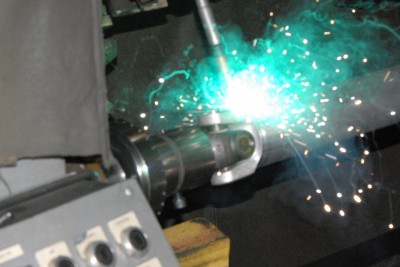 Rather than mince up his words, we’re letting Steve Raymond, Dynotech’s GM tell us what’s what:
Rather than mince up his words, we’re letting Steve Raymond, Dynotech’s GM tell us what’s what:
[box_dark]
So I understand you sent a driveshaft out the side of the car. Well one of the issues with more power and long drive shafts is a little thing called critical speed. Critical speed is the rotation speed of a driveshaft that excites the shafts first order bending frequency. Every driveshaft has a critical speed, you just need to make sure don’t spend time at the driveshafts critical speed. Critical speed is determined by driveshaft length, diameter and material. Most of the time your best option to make sure you stay away from critical speed is by changing shaft diameter. Not always easy to change shaft length. If you have three shafts (Steel, Aluminum and Carbon Fiber) all the same length then each shaft will have its own critical speed. They will rank as listed with the steel having the lowest and the Carbon Fiber having the highest critical speed. When a drive shaft spends too much time a critical speed it will normally come apart like a cardboard paper towel roll. That is to say it will unwind at approximately a 45 degree angle. You will know if you hit critical speed because you will think something serious has let loose with the amount of shaking that will happen. Most people who have hit critical speed of their driveshaft don’t spend much time their because it’s a pretty scary event.
Running some calculations on the Caprice here is what we would start to estimate to see:
With your stock setup, 3:08 gear and 25.7” tall tire your driveline speed at “X” Mph would be:
MPH Driveline Speed
90 Mph – 3,624 Rpm
100 Mph – 4,027 Rpm
110 Mph – 4,429 Rpm
120 Mph – 4,832 Rpm
130 Mph – 5,234 Rpm
Your driveshaft out of 3.0” Diameter x .083” Wall tube: 5,620 Rpm
Your driveshaft out of 3.5” Diameter x .083” Wall tube: 6,582 Rpm
Your driveshaft out of 4.0” Diameter x .083” Wall tube: 7,545 Rpm
With a different target setup using a , 4:10 gear and 25.7” tall tire your driveline speed at “X” Mph would be:
MPH Driveline Speed
90 Mph – 4,824 Rpm
100 Mph – 5,360 Rpm
110 Mph – 5,896 Rpm
120 Mph – 6,432 Rpm
130 Mph – 6,968 Rpm
You would be right there at the critical speed of the drive shaft. You also have to keep in mind our calculations are based on our new manufactured driveshaft balanced to our standards. If you running a “factory” drive shaft that has not been high speed balanced (5,000 Rpm minimum) and may have higher than desired run-out you can really drive the shaft critical speed excitement point down in Rpm. I can’t say that you did or didn’t hit critical speed during your dyno test (editor’s note: But we certainly can and we did!) but if the only thing you did is spit the driveshaft out the side of the car you got lucky. It seems any time a drive shaft fails it almost always takes something else with it. (Editor’s note: Ours wiped out an entire bell housing!)[/box_dark]
CLICK HERE TO VISIT THE DYNOTECH WEBSITE
WE’RE GOING TO SWITCH GEARS NOW AND TELL YOU THE REST OF THE STORY THROUGH PHOTOS AND CAPTIONS!
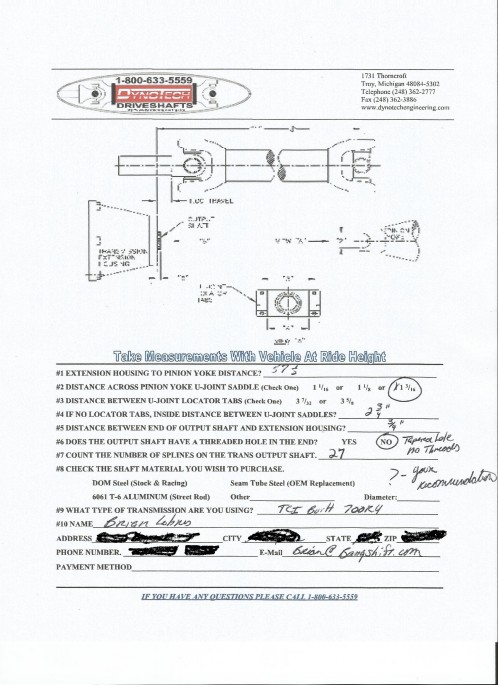
Here's the detailed measurement form we used and submitted to Dynotech. Thee directions are very clear and it is important that you are precise with your measurements. These guys do have a bunch of "on the shelf" applications, but 1987 Chevy Caprice 9C1 was not one of them...now it is!
 …meanwhile, back at Dynotech HQ in Michigan work carried on. The following photos are not my particular drive shaft but represent the manufacturing process. The tube is cut to length to start with.
…meanwhile, back at Dynotech HQ in Michigan work carried on. The following photos are not my particular drive shaft but represent the manufacturing process. The tube is cut to length to start with.

Next, the universal joints are installed and they aren't chain parts store pieces, these are the highest quality Spicer U-joints that they make!
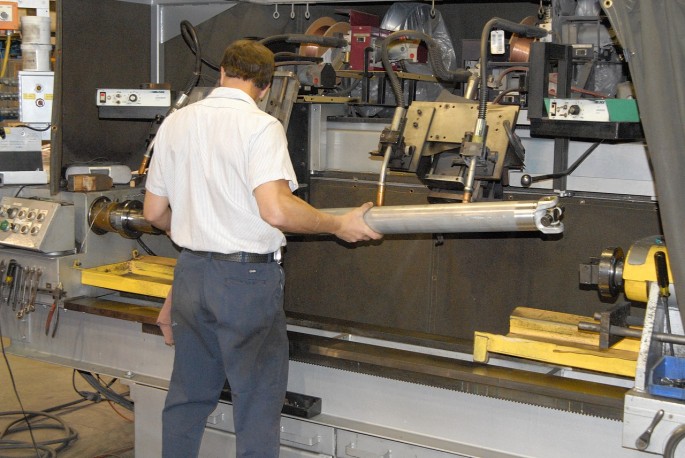
The shaft is then balanced at a minimum of 5,000 RPM on this huge balancing machine. Dynotech provides the vast majority of the shafts for NASCAR teams, so they know how to build bombproof parts. When it is last time you heard of a NASCAR team dropping out of a race because of a drive shaft failure?

The tube is constantly checked for run out and straightness. It is also balanced precisely to negate vibration. These steps are far above and beyond OEM manufacturing.
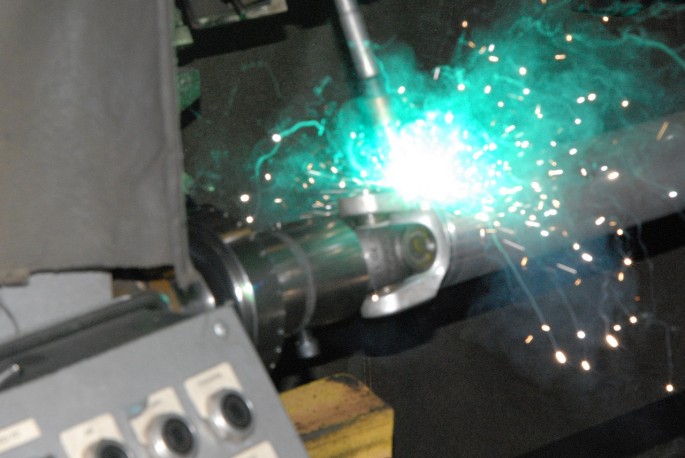
Here's the welding machine making its magic. The welds are total perfection on out shaft and will be for yours, too.

After all the final QC checks are made at the factory in Michigan, it gets shipped to the end user (me!). This was the week I had the Taurus SHO press car so I placed the driveshaft in the truck to see if it would face. Even the cavernous SHO trunk couldn't handle the length of this thing.

With all of the work put into this piece, we have no idea why anyone would screw with it, but Dynotech puts some pretty clear notes on the product to remind people that it isn't a good idea.

Here's a stark comparison. The new shaft is 4" 6061 aluminum. The old one is a crusty, rusted factory piece that is 3" diameter in the middle and 2.75 necked down on the ends.

Here's the "toe tag" that lives on the drive shaft through production. It has the vital information on it about materials and other details that need to be included.
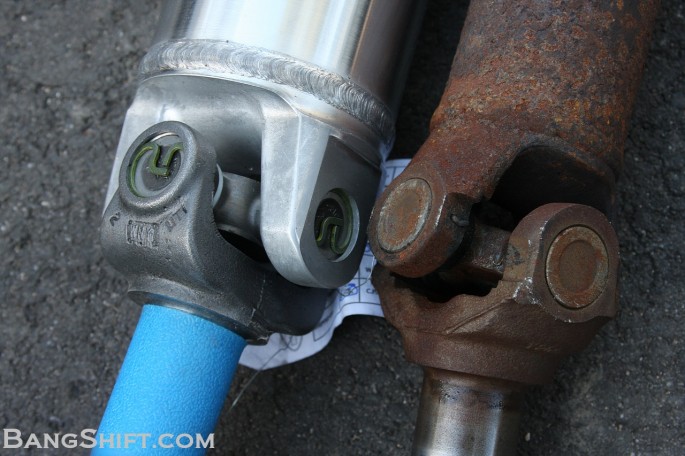
A look at the beefy Sonnax yoke versus the factory one quickly reveals the brute strength of this piece. There is really no comparison.

Think that there is no difference in universal joints? Here's the no-name chain parts store joint I put in the replacement factory shaft a couple months back...

The beefy Spicer uinversal joints with their tension ring retainers are far superior to the interior clip style no name replacements we had in the other shaft.

As Steve Raymond mentioned above, one of the ways to increase critical speed is to go to a larger diameter shaft. This 4" 6061 aluminum piece dwarfs the old steel one.

Another side by side shot to give you an idea of the size difference. Because the Caprice is a large car, fitting this larger drive shaft was not an issue. Your mileage may vary depending on application.

The new shaft fit perfectly in the car, which is only worth mentioning because I was the one doing the measuring.
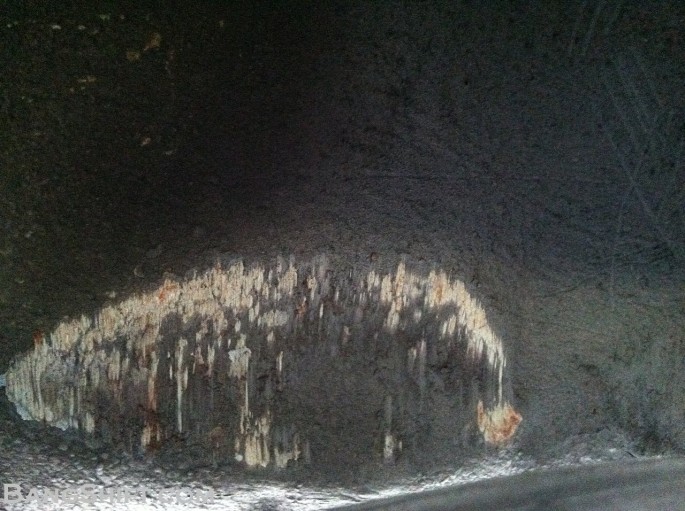
There are plenty of reminders under the car from the previous drive shaft failure incidents. We're sleeping lots easier with this Dynotech piece in place!

The fitment is great and we've put about 200 miles on the car since installing the new Dynotech driveshaft with no issues, vibrations or problems.

We had a great experience with Dynotech and totally recommend you check them out for your drive shaft needs. Call them on the phone or visit their website -- www.dynotecheng.com
CLICK HERE TO VISIT THE DYNOTECH WEBSITE
- Introducing Project Buford T Justice – Our 1987 9C1 Chevy Caprice – The Adventure Begins!
- Project Buford T Justice: Our Cop Car Cruises Home and Then We Beat on It!
- Driveway Tech: Bodywork on Buford T Justice – We Close Our Roof Hole For Fun and (NO) Profit!
- Project Buford T Justice Hits the Strip with Some Pretty Shocking Results!
- Project Buford T Justice Hits the Dyno and Goes KABLOOEY! CARNAGE VIDEO INSIDE!
- Project Buford T Justice Will Be Saved For About A 100 Bucks With a 15 Year Old Transmission
- Project Buford T Justice Update: The Trans Thrash is ON!
- Buford T Justice Update: It Lives Again Thanks to a Down and Dirty Driveway Thrash and Junkyard Parts
- Buford T Justice, Our 1987 9C1 Chevy Caprice Goes Through Final Testing Before the Upgrades Begin!
- Buford T Justice 9C1 Update: The Parts From Hotchkis, Cragar, AFCO, and Mickey Thompson
- Update: Hotchkis Suspension & AFCO Bushings Transform Our 9C1 Caprice
- Buford Update: Our 9C1 Caprice Gets Real With Mickey Thompson Tires and Cragar Wheels
- Driveway Tech: How To Swap A Jeep Steering Shaft Into Your GM B-Body or G-Body Car With A Trashed Rag Joint
- Buford Update: We Flog The Suspension, Unveil a Mountain of Speed Parts, Spill Our Wild Drag Strip Plan
- Project Buford T Justice Update: Drag Strip Thrash Squashed By Ma Nature – We Learn Stuff – Plan B!
- Project Buford T Justice Quick Update: Where The Hell Has Our 9C1 Caprice Been?!
- Project Buford T Justice: We Go On Hot Pursuit Of Horsepower-Our 9C1 Caprice’s 350 Gets A Slap!
- Buford T Justice 9C1 Caprice Update: Metal Fab,Head Work, A Good Surprise, An Awful One
- Buford T Justice Update: Headers, Cheap LS Technology, New Valvetrain Parts, More Compression, Fun!
- Buford T Justice Update: A TCI 700R4 And Breakaway Torque Converter Get Our 9C1 Caprice Shifty!
- Buford T Justice Update: A Very Frustrating Day On The Dyno And How We’re Planning To Fix It
- Project Buford T Justice Update: Where Has Our 9C1 Caprice Been Hiding?
- Buford T Justice Update: We Install A First Gen Chevelle Flowmaster Kit On Our 9C1 Caprice!
- Project Buford T Justice: Our Caprice 9C1 Gets The Shaft! A Dynotech Drive Shaft That Is!
- Project Buford T Justice Our 1987 9C1 Caprice Hits The SCCA Autocross – Photos And Video!
- Project Buford T Justice Update: We Finally Give Our 1987 9C1 Caprice A Cheapo Nose Job!
- Project Buford T Justice Update: We Hit The Strip Again With More Power! (W/Video)
- Buford T Justice Update: We Bolt On Power From Trick Flow And Snappy Looks From Trans Dapt!
- Project Buford T Justice Update: Where The Heck It’s Been And Where The Hell It is Going –
- Place Your Bets For A BangShift Shirt! Buford T Justice Is Hitting The Dyno With This Engine One Last Time – Guess The Power And Win
- Project Buford T Justice: The Long Arm Of The Law Gets Longer With A Stroker Build – 388ci Of Budget Fun





















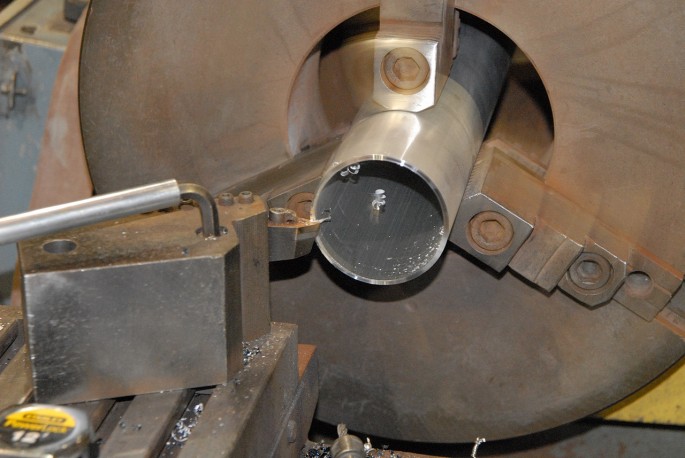

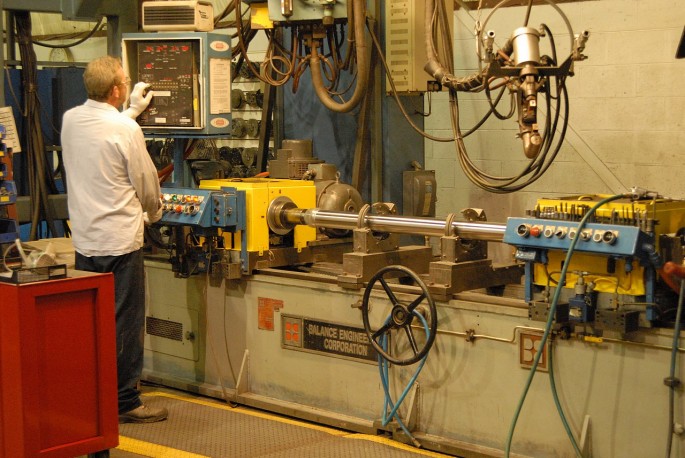




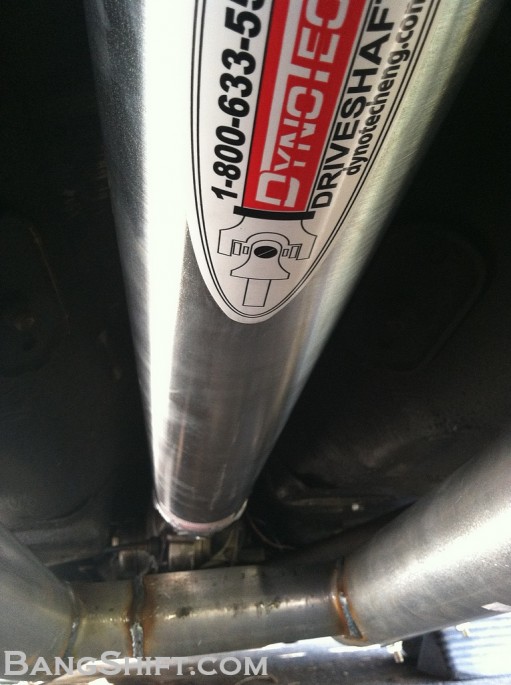





Thank god my shaft is short!…..wait that didn’t come out as intended…..
Great tech piece! Glad to see that Buford’s drive shaft puking days are over.
Brian,did you have a vibration before? Did this cure it?
So, I guess this a dead project car? Been about a month since the last update.